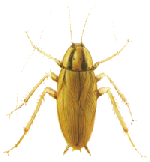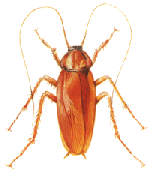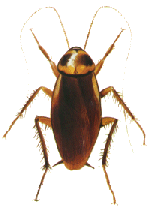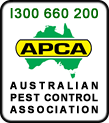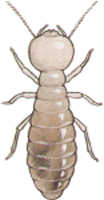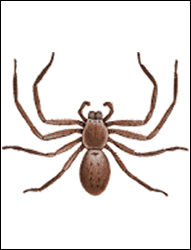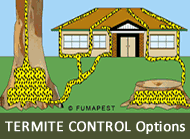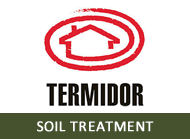| FUMAPEST Advice • Pest Control • Cockroaches |
| Professional Pest Control in the Southern Illawarra Area - Since 1964 | ||
       |
||
| Cockroaches are obnoxious pests... |
| Cockroaches carry diseases such as salmonella, dysentery, gastroenteritis and other stomach complaint organisms. Cockroaches adulterate food and spread pathogenic organisms with their faeces and defensive secretions.
Asthmatic reactions: Cockroaches moult regularly throughout their life-cycle. The discarded skin becomes airborne and can cause severe asthmatic reactions, particularly to children, the elderly and people with bronchial ailments. The cockroach begins as an egg: The female produces an egg sac which she carries or deposits in a safe place. The young cockroach or "nymph" will undergo a series of moults, shedding it's external skeleton, as it grows to adulthood. The entire life cycle may extend to a few months depending on the species and environmental factors, such as, access to food and moisture, adequate shelter and warm temperatures. Even the cleanest homes get'em: Cockroach pests and their eggs are spread throughout the community in food and other packaging. Although sanitation and hygiene are important deterrants, even the cleanest homes become infested with cockroaches due to minute deposits of grease, sugar and other food deposits in difficult to get at places, such as, in drains, behind refrigerators and dishwashers, inside cracks and crevices in kitchen cupboards. Omnivorous by nature: Cockroaches will eat almost any organic matter no matter how rancid. Once inside the home, they will seek out food scraps, unsealed food containers, sugar and grease deposits, pet food, rancid meat, glue and even book bindings. YUCK...they eat each others faeces, to feed the young "nymphs" and extract all nourishment from an organic food source. If you see a clump of pepper-like specs in your kitchen cupboards, it is likely cockroach faeces marking their courtship and nearby nesting territory. Nocturnal feeders: Cockroaches rest during daylight hours in dark warm secure harborages in your home, such as, in wall cavities, the subfloor, roof void, cracks and crevices in the kitchen and bathroom, electrical appliances and foodstuffs. They will emerge from these harborages in the still of the night. Cockroaches have an array of acute sensory and survival instincts. If you see cockroaches in your home during the day, you have a serious problem. Rapid breeding cycle: If left unchecked a cockroach infestation can rapidly expand it's numbers in a few weeks or months to become major risk to health and safety. |
||
| Professional Pest Control for Cockroaches |
| Modern science has the answer: These days, the professional pest controller has access to cockroach bait technologies. The modern technology cockroach baits is designed as a palatable food source for cockroaches which has a delayed lethal effect. The bait is readily transferred and fed to other cockroaches. The male cockroach is the primary food gatherer. The female eats his faeces as a food source and passes it onto the young nympths - spreading the bait throughout the entire population.
Safety first: The modern cockroaches baits are formulated as a gel and is of ultra low hazard to people, dogs, cats and other mammals. Applied as small blobs in kitchen cupboards and other likely and observed cockroach habitat areas away from human contact, the gel-bait is highly attractive to cockroaches and provides effective control, usually for many months. The gel baits are highly effective against german cockroaches. Permethrin dust application is recommended for use in wall cavities, roof voids and some subfloor areas. This dust has excellent floatation properties to enable it to be applied directly into such hard to get at areas where cockroaches congregate and breed. Considered essential for severe infestations. The Permethrin dust is modelled on the natural extract of pyrethrum plant and is less toxic than common salt to humans. A liquid insecticidal spray is often required in some areas to gain effective control, such as interior skirting boards, sheds, garages, fencelines, garbage refuse areas, around top of drains and immediate external perimeter of buildings. |
||
| The Cost of Professional Cockroach Control |
 |
The cost of professional pest control for cockroaches using the above recommended insecticides, will depend upon several factors, including the size of the property, the extent of infestation and ease of access to treatment areas.
Expect to pay approximately from $230 depending on the size of the premises, for thorough application of cockroach baits and pyrethroid insectical treatment of cockroach habitat areas. Service warranties may vary depending upon the circumstances, condition of the premises and the risk of reinfestation. |
Commercial premises food handling businesses, restaurants, function centres commercial offices, factories and warehouses will need to be appraised and quoted for on a specific basis, and may require monthly servicing to retain effective control. Ring the experts: successful pest control of cockroaches depends on many variables learnt from technical training and practical experience in a wide variety of situations. Consumer note: you may find cheaper prices for cockroach control in your local area, from companies using the cheaper solvent based pesticides in and around the home, which we do NOT recommend, especially if residents suffer asthma or bronchial ailments. Receive a discount: We recommend whilst the pest controller is at your premesis to also have it checked for termite infestation. Building insurances do NOT cover the cost of termite damaged timbers which could exceed $50,000 in severe cases. If a combined service is done on the same day, the cost of such an inspection and report to Australian Standard 3660 should be discounted accordingly - for more details. Be careful when selecting a pest controller - it's far too easy to get a NSW Govt issued pest control licence and start up a pest control business, using trainees with little knowledge or experience in pest control - for more details |
||
| What the home owner can do |
| Inspection: First, inspect the entire kitchen area, under sinks, refrigerator, dishwasher, stove, microwave oven, other cooking appliances, bathroom cabinets, draws, basement and subfloor crawlspace (if any) for likely high activity and harborage areas. Look for cockroaches, alive or dead, their faeces and egg sacs.
Identification: Place "sticky" glue traps in any likely high activity areas. At night sneak into the kitchen, turn on the lights and observe any cockroach activity. Observe where they scurry to. Place your sticky traps near these areas to collect and identify the species and the source of infestation. Food, shelter and water: We all need it, so do cockroaches. Make your home unfit for cockroaches, where possible, take away their food, water and restrict shelter and access points into the kitchen and they will almost certainly move somewhere else. Starve them out: Keep all food in sealed containers. Particularly at night, do not leave food scraps exposed in the kitchen or waste storage areas. Thoroughly clean all benches and food preperation areas, particularly between counters and appliances. Regularly vacuum accessible likely harbourage and high acivity areas, carpets, drapes, furniture, kitchen and bathroom cupboards in order to remove cockroach eggs and food deposits. Cockroaches need water: Cockroaches will thrive in damp subfloor crawl space areas, near leaking taps, etc. Ensure adequate drainage and ventilation. Regularly check and fix any plumbing problems, broken roof tiles, etc that may allow or cause moisture agress to potential cockroach harborage areas. Wipe kitchen sink of moisture before retiring or going out at night. Turn off leaking taps. Reduce shelter and access points: Seal all cracks and crevices in bathroom, pantry and kitchen cupboards. Store all cardboard boxes and the like above ground level. Cockroaches do not like drafty exposed areas, nor bright lights. A good reason why some restaurants keep lights on at night around their dumpster waste bins. |
||
| Cockroach species identification |
| Correct identification is essential: There are several cockroach pest species that infest domestic and commercial premises. The identification of each species is neccessary to best determine likely harborage areas and an effective pest control program. | ||
| German cockroach - Blatella germanica |
World best traveller? The German cockroach is the most widely transported insect pest in the world. Infestations occur even in Alaska and other cold climates in larger installations with central heating or around machinery that produces heat. In warmer climates, it is commonly found in homes, apartments, restaurants, food processing plants, supermarkets and warehouses. Their eggs arrive in food containers, cartons, fridges, stoves and other appliances or materials brought into a building. Habitat: German cockroaches are unable to survive in locations away from humans or human activity. German cockroach infestations usually occur in bathrooms and kitchens. They like to hide-out during the day in tight secure places. Daytime harborage areas are usually near a food and moisture source, such as, inside wall cavities, behind baseboards, cracks and crevices in pantry, kitchen and bathroom cupboards, and under electrical, heating and cooking appliances. Rapid breeding cycle: The German cockroach is the most prolific breeder among all cockroaches. The female German cockroach lives up to 6 months. She carries an egg capsule containing 30 to 40 eggs. Development from egg to adult can occur in 45 days, during which they moult 6 times. Major problems: lThe German cockroach will breed rapidly throughout the year, but favours a humid environment of around 80F or warmer. An small initial infestation can become a major problem in a few months. |
|||
| American cockroach - Periplaneta americana |
Habitat: Preferred daytime habitat locations include the subfloor, basement, in sewers and other warm, dark, moist locations. They avoid cold areas but will thrive outdoors in temperatures above 80F. Indoors they often congregate around hot water pipes, fridge motors, boilers and other heating appliances. The American cockroach will feed on a wide variety of plant and animal material. Rapid breeding cycle: The female life span up to 1.5 years; incubation period of eggs 6 to 8 weeks; in ideal conditions they quickly reach plague proportions. |
|||
| Oriental cockroach --- Blatta orientalis |
Habitat: Most often found in dark basements or cellars, but can also climb garbage shutes, sewer and water pipes to the upper floors in highrise buildings. Oriental cockroaches prefer to feed on starchy foods. Rapid breeding cycle: The female lives up to 2 years; deposits up to 18 egg-sacs in lifetime; each eggsac contains 16 eggs; incubation period is 1 to 2 months; development period is 12 months, undergoing 7 moults. An infestation will rapidly expand in ideal conditions, particularly during the warm summer months with temperatures regularly above 80F. |
|||
| Australian cockroach --- Periplanta australasiae |
| FUMAPEST Termite & Pest Control in Southern Illawarra Area |
|
|||||||||||
| WARNING: The NSW Govt EPA Pest Control Licensing is INADEQUATE |
The NSW Pest Control Licensing system is subject to National Competency Assessment guidelines. Mediocre testing can be carried by Private Workplace Assessors (not part of TAFE system). The so called competency assessment can be a combination of oral, written and visual tests. Private Workplace Assessors are given general guidelines in the National Competency Standards but there is no set standard test or specific knowledge requirements. Once privately assessed as "competent" then the NSW Govt EPA Pest Control Licensing will issue a pest control licence to the individual. There is no published list of Private Workplace Assessors.. The System is Inadequate: Some Private Assessors offer a one week course. A person so issued with a pest control licence can set up a Pest Control business (not required to register with EPA Licensing Authority and employ many trainees, using pesticides in people's homes without direct personal supervision. FUMAPEST Setting the Standard in an industry plagued by fly-by-night operators, FUMAPEST Termite & Pest Control stands out as a well established pest control business with excellent reputation in the market-place. Same Family Business • Since 1964 • Termite & Pest Control Specialists. |
||||||||||||||||
| FUMAPEST Termite & Pest Control Services |
Commercial Food Premises • FUMAPEST Pest Control is compliant with Food Act NSW, HACCP & AQIS requirements for commercial food handling premises in kiama Council Region • restaurants • cafes • bakeries • backpacker hostels • child care centres • churches • factories • health care facilities • hospitals • hotels • motels • nursing homes • offices • racehorse stables • retirement villages • schools • colleges • veterinary clinics • other sensitive environments • click here for more details. Termite Control Specialists • AS.4349 Termite Inspection Reports • Termite Baiting • Termite Colony Elimination • Exterra termite bait • Nemesis termite bait • Sentricon termite bait • AS3660 Termite Preventive Barriers • Termiticides • Altriset • Termidor fipronil • Premise imidacloprid • click here for more details. KORDON Termite Barrier for Builders • Manufactured by Bayer Australia • FUMAPEST Termite & Pest Control are Licensed KORDON Installers for building constructions in the Southern Illawarra Area • KORDON is CodeMark Accredited and meets Australian Building Code and kiama Council termite control requirements for buildings under construction • a 10 year warranty applies backed by Bayer • click here for more details. Professionally Trained Technicians • The FUMAPEST Termite & Pest Control Training Program regularly assesses and updates technician skills in the use of latest generation products and our EcoSafe Pest Control systems • all termite control technicians have the APCA or TAFE Pest Control Certificate • NSW Govt WorkCover Pest Control Licence • and many years field-work experience in termite control. |
||||||||||||||||||||||||
| Links to websites on pest control for cockroaches |
| Colorado State University - expert information and advice on cockroach pest species, cockroach control methods, residual insecticidal sprays, dusts and baits, preventive measures and house maintenance tips..
Cornell University - excellent website providing information on cockroach pest species; integrated pest management procedures applicable to cockroach control; and references to leading textbooks and articles. New Mexico State University - information on cockroaches and pest control products. University of Alaska - yes, there are cockroach problems in Alaska. The University of Alaska entomology department discusses the cockroach pest species found in Alaska and the methods of control. University of California - excellent comprehensive website providing a detailed analysis of cockroach pest species, cockroach pest control products and procedures, nonchemical housekeeping and maintenance recommendations. |
||
| FUMAPEST Pest Control - Service Territory - Southern Illawarra Area |
